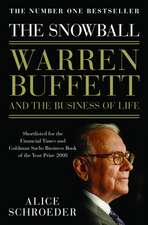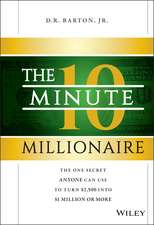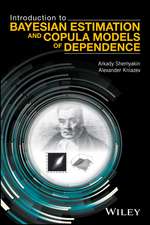Environmental Finance and Investments: Springer Texts in Business and Economics
Autor Marc Chesney, Jonathan Gheyssens, Anca Claudia Pana, Luca Taschinien Limba Engleză Hardback – 28 noi 2015
What is the nature of the relation between economic growth and the environment?
This book intends to provide students and practitioners with the knowledge and the theoretical tools necessary to answer these and other related questions in the context of the so-called environmental finance theory. This is a new research strand that investigates the economic, financial, and managerial impacts of carbon pricing policies.
| Toate formatele și edițiile | Preț | Express |
|---|---|---|
| Paperback (1) | 449.53 lei 6-8 săpt. | |
| Springer Berlin, Heidelberg – 23 aug 2016 | 449.53 lei 6-8 săpt. | |
| Hardback (1) | 529.28 lei 6-8 săpt. | |
| Springer Berlin, Heidelberg – 28 noi 2015 | 529.28 lei 6-8 săpt. |
Din seria Springer Texts in Business and Economics
- 17%
 Preț: 460.17 lei
Preț: 460.17 lei -
 Preț: 548.25 lei
Preț: 548.25 lei - 17%
 Preț: 490.71 lei
Preț: 490.71 lei - 13%
 Preț: 447.86 lei
Preț: 447.86 lei - 19%
 Preț: 509.83 lei
Preț: 509.83 lei -
 Preț: 360.02 lei
Preț: 360.02 lei -
 Preț: 374.88 lei
Preț: 374.88 lei - 17%
 Preț: 523.87 lei
Preț: 523.87 lei -
 Preț: 374.15 lei
Preț: 374.15 lei -
 Preț: 185.09 lei
Preț: 185.09 lei - 17%
 Preț: 522.65 lei
Preț: 522.65 lei - 19%
 Preț: 465.61 lei
Preț: 465.61 lei - 15%
 Preț: 642.51 lei
Preț: 642.51 lei - 18%
 Preț: 754.79 lei
Preț: 754.79 lei - 19%
 Preț: 534.44 lei
Preț: 534.44 lei -
 Preț: 360.47 lei
Preț: 360.47 lei -
 Preț: 359.93 lei
Preț: 359.93 lei - 17%
 Preț: 363.29 lei
Preț: 363.29 lei - 17%
 Preț: 363.98 lei
Preț: 363.98 lei -
 Preț: 473.41 lei
Preț: 473.41 lei -
 Preț: 361.12 lei
Preț: 361.12 lei - 8%
 Preț: 428.31 lei
Preț: 428.31 lei - 15%
 Preț: 479.55 lei
Preț: 479.55 lei - 13%
 Preț: 490.93 lei
Preț: 490.93 lei - 15%
 Preț: 650.55 lei
Preț: 650.55 lei -
 Preț: 382.19 lei
Preț: 382.19 lei - 15%
 Preț: 562.13 lei
Preț: 562.13 lei -
 Preț: 367.41 lei
Preț: 367.41 lei -
 Preț: 401.79 lei
Preț: 401.79 lei -
 Preț: 361.89 lei
Preț: 361.89 lei - 15%
 Preț: 562.31 lei
Preț: 562.31 lei - 17%
 Preț: 491.52 lei
Preț: 491.52 lei - 20%
 Preț: 819.24 lei
Preț: 819.24 lei - 15%
 Preț: 597.20 lei
Preț: 597.20 lei -
 Preț: 320.05 lei
Preț: 320.05 lei - 20%
 Preț: 694.03 lei
Preț: 694.03 lei - 20%
 Preț: 693.46 lei
Preț: 693.46 lei -
 Preț: 548.53 lei
Preț: 548.53 lei - 17%
 Preț: 459.67 lei
Preț: 459.67 lei - 17%
 Preț: 366.16 lei
Preț: 366.16 lei - 20%
 Preț: 693.82 lei
Preț: 693.82 lei -
 Preț: 555.90 lei
Preț: 555.90 lei - 9%
 Preț: 766.64 lei
Preț: 766.64 lei
Preț: 529.28 lei
Preț vechi: 622.68 lei
-15% Nou
Puncte Express: 794
Preț estimativ în valută:
101.28€ • 106.50$ • 83.68£
101.28€ • 106.50$ • 83.68£
Carte tipărită la comandă
Livrare economică 17 aprilie-01 mai
Preluare comenzi: 021 569.72.76
Specificații
ISBN-13: 9783662481745
ISBN-10: 366248174X
Pagini: 209
Ilustrații: VII, 197 p. 72 illus., 36 illus. in color.
Dimensiuni: 155 x 235 x 20 mm
Greutate: 0.47 kg
Ediția:2nd ed. 2016
Editura: Springer Berlin, Heidelberg
Colecția Springer
Seria Springer Texts in Business and Economics
Locul publicării:Berlin, Heidelberg, Germany
ISBN-10: 366248174X
Pagini: 209
Ilustrații: VII, 197 p. 72 illus., 36 illus. in color.
Dimensiuni: 155 x 235 x 20 mm
Greutate: 0.47 kg
Ediția:2nd ed. 2016
Editura: Springer Berlin, Heidelberg
Colecția Springer
Seria Springer Texts in Business and Economics
Locul publicării:Berlin, Heidelberg, Germany
Public țintă
Upper undergraduateCuprins
Introduction.- The issue of climate change.- The rise of emission markets.- The economics of mitigation.- Economic growth and the environment.- The finance of environmental investments.- Emission price dynamics.
Recenzii
“Contributors are to be congratulated since they produced a very good text on environmental finance and economics academically valuable and very useful for practitioners. An outstanding work, providing a very agreeable reading, simultaneously rigorous and pedagogic, written specially for undergraduate and graduate students, journalists, policy makers and NGOs. Indispensable for academics and practitioners in the field of environmental finance and investments. Accessible to anyone curious on these matters.” (Manuel Alberto M. Ferreira, International Journal of Latest Trends in Finance & Economic Sciences, Vol. 6 (2), June, 2016)
“Environmental Finance and Investments … analyze environmental commodity markets and how they can attract investments. … The book also provides an insightful review of the real-option approach as a viable decision-making tool for achieving compliance with environmental regulations. … can be read linearly, chapter by chapter, or it can be used by fund managers, regulatory investors, and green-finance experts as a reference to gain valuable insights into how to manage carbon markets.” (Joseph Nyangon, Financial Analysts Journal, cfapubs.org, Vol. 11 (1), 2016)
“Environmental Finance and Investments … analyze environmental commodity markets and how they can attract investments. … The book also provides an insightful review of the real-option approach as a viable decision-making tool for achieving compliance with environmental regulations. … can be read linearly, chapter by chapter, or it can be used by fund managers, regulatory investors, and green-finance experts as a reference to gain valuable insights into how to manage carbon markets.” (Joseph Nyangon, Financial Analysts Journal, cfapubs.org, Vol. 11 (1), 2016)
Notă biografică
Marc Chesney holds a Ph.D. in Finance from the University of Geneva and obtained his habilitation from the Sorbonne University. He is currently Professor of Finance and Vice-Director of the Department of Banking and Finance of the University of Zurich where he created the Environmental Finance course. He is an expert in quantitative finance (real options) and environmental economics. He was previously Professor and Associate Dean at HEC Paris.
Jonathan Gheyssens holds a PhD in Economics from the NADEL Center for Development and Cooperation at ETH Zurich and is in charge of economic research activities for the REDD+ Finance and Sustainable Land Use division of UNEP’s Finance Initiative based in Geneva, Switzerland. His research is focused on real options, environmental and climate economics, and REDD schemes.
Anca Claudia Pana is a young researcher at the University of Zurich, Switzerland. She completed her Bachelor studies in Banking and Finance atthe University of Bucharest, Romania. In 2010, she graduated from the MSc in Financial Engineering and Risk Management at HEC Lausanne, Switzerland. Since then she is enrolled in the PhD program at the University of Zurich, under the supervision of Prof. Dr. Marc Chesney. Her research interests are environmental and resource economics, market failures, real options, and development economics.
Luca Taschini is an expert in environmental economics, industrial organisation, energy economics, finance and the application of economics to public policy issues. He is a Research Fellow at the Grantham Research Institute at the London School of Economics where he leads the Carbon Trading and Finance research programme. His current research investigates how market-based environmental regulations are working in theory and in practice. More specifically, he is studying the functioning of cost containment mechanisms, market participation restrictions, and the linkage of environmentalmarkets. He has led consulting work on market-based instruments including work on designing emission trading systems and the design of the EU Market Stability Reserve and other supply control mechanisms. He holds an Ph.D. in Economics from the University of Zurich, and an M.A. in Politics and Economics from the University of Bergamo. He was also a visiting scholar at the Joint Program on the Science and Policy of Global Change (MIT) and at the Research Center for Sustainability Science (Ritsumeikan University - Japan).
Jonathan Gheyssens holds a PhD in Economics from the NADEL Center for Development and Cooperation at ETH Zurich and is in charge of economic research activities for the REDD+ Finance and Sustainable Land Use division of UNEP’s Finance Initiative based in Geneva, Switzerland. His research is focused on real options, environmental and climate economics, and REDD schemes.
Anca Claudia Pana is a young researcher at the University of Zurich, Switzerland. She completed her Bachelor studies in Banking and Finance atthe University of Bucharest, Romania. In 2010, she graduated from the MSc in Financial Engineering and Risk Management at HEC Lausanne, Switzerland. Since then she is enrolled in the PhD program at the University of Zurich, under the supervision of Prof. Dr. Marc Chesney. Her research interests are environmental and resource economics, market failures, real options, and development economics.
Luca Taschini is an expert in environmental economics, industrial organisation, energy economics, finance and the application of economics to public policy issues. He is a Research Fellow at the Grantham Research Institute at the London School of Economics where he leads the Carbon Trading and Finance research programme. His current research investigates how market-based environmental regulations are working in theory and in practice. More specifically, he is studying the functioning of cost containment mechanisms, market participation restrictions, and the linkage of environmentalmarkets. He has led consulting work on market-based instruments including work on designing emission trading systems and the design of the EU Market Stability Reserve and other supply control mechanisms. He holds an Ph.D. in Economics from the University of Zurich, and an M.A. in Politics and Economics from the University of Bergamo. He was also a visiting scholar at the Joint Program on the Science and Policy of Global Change (MIT) and at the Research Center for Sustainability Science (Ritsumeikan University - Japan).
Textul de pe ultima copertă
This textbook provides an introduction to environmental finance and investments. The current situation raises fundamental questions that this book aims to address. Under which conditions could carbon pricing schemes contribute to a significant decrease in emissions? What are the new investment strategies that the Kyoto Protocol and the emerging carbon pricing schemes around the world should promote? In the context of carbon regulation through emission trading schemes, what is the trade-off between production, technological changes, and pollution?
What is the nature of the relation between economic growth and the environment?
This book intends to provide students and practitioners with the knowledge and the theoretical tools necessary to answer these and other related questions in the context of the so-called environmental finance theory. This is a new research strand that investigates the economic, financial, and managerial impacts of carbon pricing policies.
What is the nature of the relation between economic growth and the environment?
This book intends to provide students and practitioners with the knowledge and the theoretical tools necessary to answer these and other related questions in the context of the so-called environmental finance theory. This is a new research strand that investigates the economic, financial, and managerial impacts of carbon pricing policies.
Caracteristici
Analyses the effects of carbon pricing schemes on emissions, economic growth and investments Investigates the economic, financial, and managerial impacts of carbon pricing policies Written for undergraduate and graduate students, journalists, policy makers and NGOs Includes supplementary material: sn.pub/extras



















